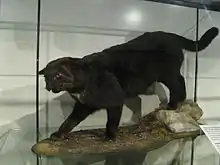Kellas cat
The Kellas cat is a large black cat found in Scotland. It is an interspecific hybrid between the Scottish wildcat (Felis silvestris silvestris syn. Felis silvestris grampia) and the domestic cat (Felis catus). Once thought to be a mythological wild cat, with its few sightings dismissed as hoaxes, a specimen was killed in a snare by a gamekeeper in 1984[1][2] and found to be a hybrid between the Scottish wildcat and domestic cat.[3] It is not a formal cat breed, but a landrace of felid hybrids. It is named after the village of Kellas, Moray, where it was first found. The purported first live cat was caught by the Tomorrows World team and featured in the 1986 programme 'On the Trail of the Big Cat'.. The historian Charles Thomas speculated that the Pictish stone at Golspie may depict a Kellas cat.[4] The Golspie stone, now held at the Dunrobin Castle Museum, shows a cat-like creature standing on top of a salmon which may allude to the characteristics ascribed to a Kellas cat of catching fish while swimming in the river.[5]
| Kellas cat | |
|---|---|
 | |
| Mounted zoological specimen of a Kellas cat | |
| Scientific classification | |
| Kingdom: | Animalia |
| Phylum: | Chordata |
| Class: | Mammalia |
| Order: | Carnivora |
| Suborder: | Feliformia |
| Family: | Felidae |
| Subfamily: | Felinae |
| Genus: | Felis |
| Species: | |
A researcher at the National Museum of Scotland examined eight Kellas cat specimens.[5] One carcass was already in the Museum's collection; the remaining seven were supplied by Di Francis,[6] who is described by Thomas as a "writer, researcher and practical naturalist".[5] He identified one of the animals as a melanistic wildcat;[5] this juvenile male was the first wildcat ever documented as melanistic in Scotland.[7] Most of the other specimens examined were concluded to be hybrids but more closely aligned to the Scottish wildcat; only one hybrid leaned more towards a domestic cat.[7]
The Kellas cat is described as being twenty-four to thirty-six inches (61 to 91 cm) long, with powerful and long hind legs and a tail that can grow to be around twelve inches (30 cm) long; its weight ranges from five to fifteen pounds (2.3 to 6.8 kg). The animal snared in 1984 was fifteen inches (38 cm) to shoulder height and forty-three inches (110 cm) in length.[8] A specimen is kept in a museum in Elgin.[9] The Zoology Museum of the University of Aberdeen also holds a mounted specimen that was found during 2002 in the Insch area of Aberdeenshire.[10][11]
See also
References
- Bowers, Aron, "Kellas Cats, Scotching the Myth", Scottish Big Cat Trust, archived from the original on 14 September 2015, retrieved 4 October 2015
- Francis (1993), p. 3
- Nowak (2005), p. 237
- Thomas (2013), p. 175
- Thomas (2013), p. 174
- Kitchener (1993), p. 211
- Kitchener (1993), p. 213
- Francis (1993), p. 6
- "Elgin Museum, collection", Museums Galleries Scotland, archived from the original on 5 March 2016, retrieved 4 October 2015
- "Catalogue record", University of Aberdeen, archived from the original on 7 October 2016, retrieved 4 October 2015
- Kellas cat (Notice in display cabinet). Aberdeen: University of Aberdeen.
Bibliography
- Francis, D. (1993). My Highland Kellas Cats. Cape. ISBN 978-0-224-03608-5.
- Kitchener, A. (1993). "Investigating the identity of the Kellas Cats". In Francis, D. (ed.). My Highland Kellas Cats. Cape. ISBN 978-0-224-03608-5.
- Nowak, R. M. (2005). Walker's Carnivores of the World. Johns Hopkins University Press. p. 237. ISBN 978-0-8018-8033-9.
- Thomas, C. (2013). Gathering the Fragments: The Selected Essays of a Groundbreaking Historian. Sheffield: Cornovia Press. ISBN 978-1-908878-02-1.